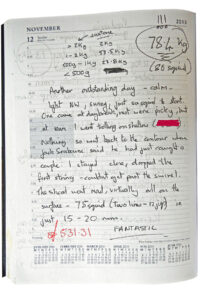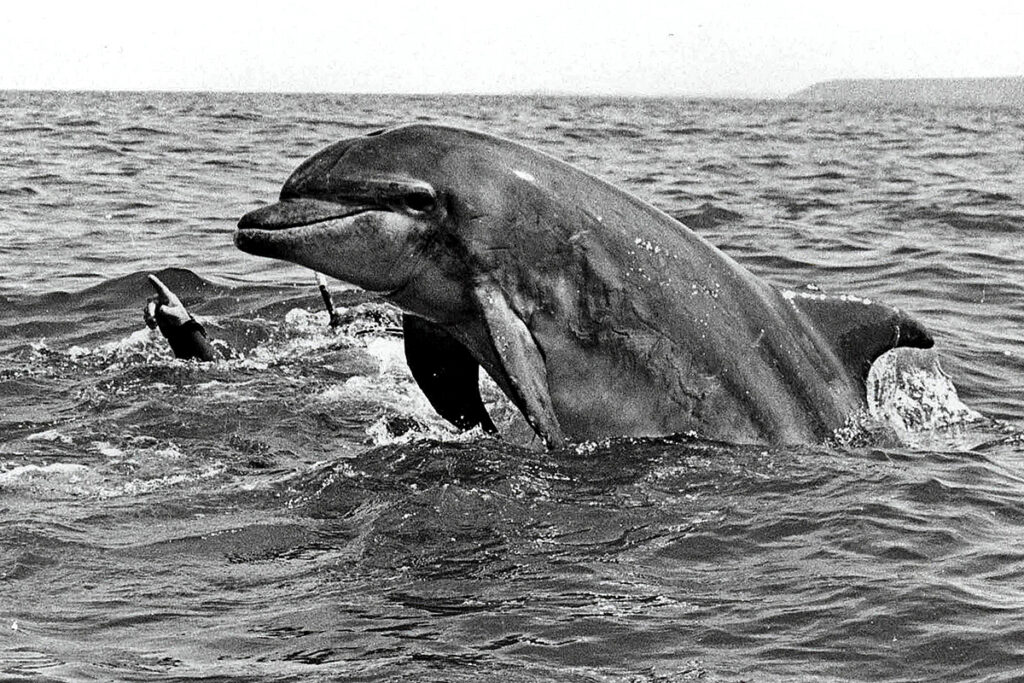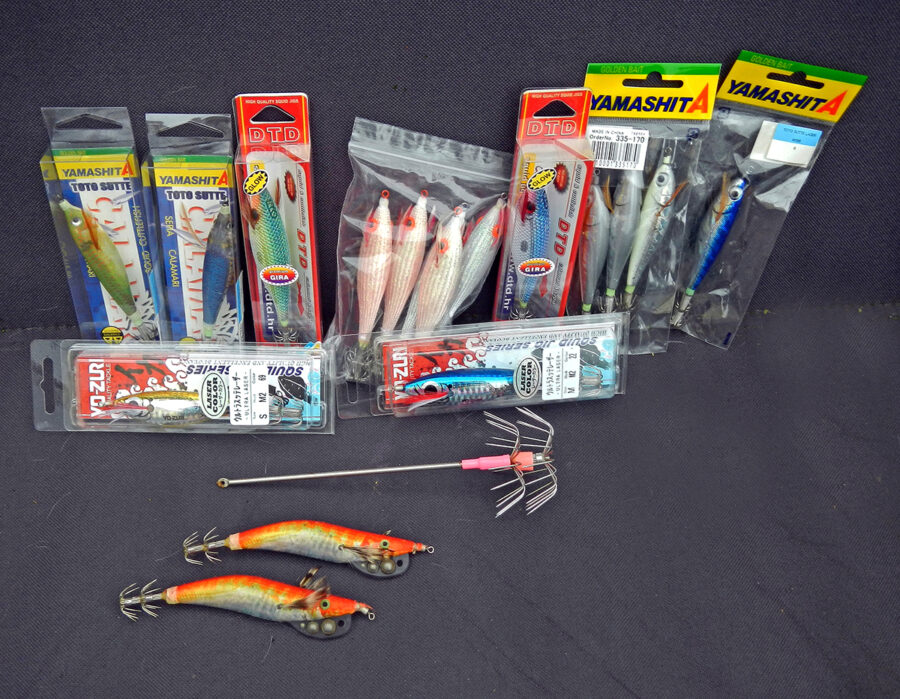Phil Lockley cautions: “This will cost you!”
Above: Have those jigs ‘caught’ me, or is that the range of gear I need?
Through two years of lost fishing time (from arthritis), a recent replacement knee means that I am now ‘titanium-rich’ – and waiting for them to sort out my ‘bad-back’! Have I passed my sell-by date?
As soon as I get my MOT I will hopefully be back chasing squid. But I must reveal how we in Britain, I was told, make very few metal replacement knees; we just send the scans to Belgium, they make the titanium knees and our surgeons fit them!

Taimor Jolly with our largest 2013 squid – 2.6kg.
On the morning preparing for the ‘knife’ – as he revealed a permanent marker pen and drew a worrying six-inch long guideline over my right knee – I asked the surgeon: “How many knees do you do in a day?”. “Normally three,” he answered. I replied: “What number am I?” “Number two today, just before lunch,” he confirmed.
Phew, it was Monday. Imagine being number one on Monday morning or worse still being number three on Friday! And what do we do after Brexit? Will we be swapping titanium knees for monk quota to Belgian beamers in Area VII?
Let’s hope 2016/2017 will be a good squid season. Squid are not predictable, neither is the weather, particularly rainfall. I would like to say how rainfall is one parameter where we can be certain of a squid’s response – plenty of rain means that the salinity level of seawater falls, the water becomes coloured and the squid head for deeper water?
If so, why do squid travel into the river Fal where even without rain there is a considerable flow from rivers and streams; or indeed into the Helford River, a place where, similarly, salinity levels vary widely? And if we believe – as scientists suggest – that Loligo forbesi will not tolerate even light sediment in seawater, why have other squidders and I caught a fair few long-finned squid in waters that divers might describe as ‘low visibility’? Looking at my diaries may reveal some sort of pattern.
Fast growers
In growth rate the squid are winners; scientists suggest that a squid may eat at least its own body weight in a single day. They have to. The long-finned squid (like others) have only 18 months to live, and by early September they must have grown from plankton stage to become an adult weighing about 250g. From September to late December they must reach an average weight – according to my diaries – of between 500g and 1.2kg, often much bigger.
So, looking at my averages of landing weight divided by the numbers of squid, during their life the growth-rate of squid is astronomical. However, scientists reckon that in December/January if a squid has not found a suitable partner to breed, it stops eating, holding back its growth rate until spring, when its final chance to mate becomes available. Is this why we find squid eggs on crab pots virtually throughout the year? Or are the scientists wrong and squid breed all year, with December/January being more prolific?
Second time round?
Fishing with Taimor Jolly in late November 2013, our biggest squid from Falmouth Bay weighed 2.6kg, and was taken from a depth of just six fathoms. And in far-west Cornwall, a 3kg-plus squid isn’t rare, I’m informed. But with a 2.6kg ‘personal best’ from Falmouth Bay, a few days later, fishing in another area close by, and at the same depth, we could catch nothing but tiny squid. As far as we could see it was the same species. Pulling our hair out – and I have plenty of that – what was the reason behind this result? It just didn’t make sense. Or were those hand-sized squid the result of the second-breeders three to four months before? Are the scientists right? And, if so, we might have two runs of big squid, October to December and February to April. Have I been missing out?
November pattern
In my diary records for 2013, I refer to average weights, and on catching that leviathan of 2.6kg, he wasn’t a monster. Here’s my diary for November 8, 2013.
‘Rain, cold and calm. Tide 4.5m/4.7m. My normal place (NB I will leave out where), I had a superb catch. I saw a very big squid follow others on the trace. I waited to see him take and he moved fast, touched the jig with his pads then shot backwards, he did it many times; there were already four on the trace. He wouldn’t bite so I started to lift the first squid into the boat and wham, he took the empty jig, right at the surface; surely he could see me? He weighed 2.6kg, the first 2kg-plus this year and the biggest I have ever caught – but there were several weighing between 1.8kg and 2kg. I wonder what they can grow to? Average weight 1.2kg from 46.8kg of squid. £356’.

Top secret!
November 11 gave 73.9kg and, again, the average weight was 1.2kg (£495.13) and the following day the diary says: ‘We had another outstanding day. Calm, light NW wind, top of the springs, sunny, just six squid until the sun rose. Too many boats again. Went further south but blanked. Boats left and we went back to the Valley and wham at 10am, trolling slowly, swapped one pole over (to port). Saw a mark. Stopped. Dropped in the trace but couldn’t get the last jig in the water, the strings were filling up, the squid were just underneath. Luckily we had no tangles. The shoal went mad. 86 squid weighed 79.7kg. Just one squid over 2kg, 53.5kg from 1-2 kg, 23.8kg from 500g-1kg, one squid about 400g (making a total of £531.31). Fantastic, all that in 15 to 20 minutes’.
I should have entered that I was knackered but Taimor wasn’t! He’s 30-something and I’m twice that; he would have fished all day! November 15 was another OK day but the big hits at that area had gone, I thought. Here’s the entry: ‘Nothing at xxxxx but saw the three St Ives’ boats on the way out – just past the yellow buoy. I steamed on. I should have stopped. I should have stuck to my instinct. Over 30 boats were north at xxxxx. I knew it wasn’t going to work, but I kept fishing. Went back near the St Ives boats and whack – but I was late – however, my instinct had paid off. One squid weighed 2.1kg. The lot made £298.82. So far I’ve landed 413.8kg for October and November. Just under £3,000.’
And it went on, but by listening to the old-timers we thought that better catches were elsewhere, so we searched to find other new places. We did OK, but after mid-December those catches were dropping; the weather was worsening. But please remember the dates in mid-November; those may be the days just before the spawning occurs. If you are going to do well (if it’s anything like here in Falmouth Bay) it will be mid-November. So don’t be late for work from November 5 until November 20, which, until I saw that pattern, I often was.
Hungry squid
In the predation of juvenile white fish, pelagic fish and prawns, scientists have never calculated the true damage done by squid. A massive amount of damage to the feed-fish stocks in the British Isles must, in my opinion, come from squid. Their hunger is huge. Take 2013 as an example, and it was a particularly good year; in truth we were only scratching at the shoals. Only luck got the ‘hits’ and you can only hold the pack for 20 minutes, sometimes much less, so just imagine the real density of the squid shoals around Britain and the result. I wonder how the trawl catches of 2013 compared to last year (2015, a really bad year here for squid line fishing) where losses from squid were surely lower.
Squid location clues
Searching for squid marks is another mystery. The best help I can give is the shape of the marks. My last sounder was a dual-frequency monochrome Furuno; and to many, the very best sounder for bottom definition is a black and white set – top class for pelagic fish too. But on hearing about a new Furuno dual-frequency colour sounder, I invested in one, but I had not forgotten skipper Dave Hurford’s choices. Now retired, his skills in midwater trawling on sprats and the like, remain legendary. He’s based in Brixham and a couple of times (for Fishing News) I joined him on day trips. Dave always preferred the black and white sounder for more detailed information of the quarry.

A dolphin I took pictures of in the early 1980s – called Percy – but dolphins are a bit too hungry when squid are around.
When squidding – for me – most times I’m catching away and there are no marks. Squid have no swim bladders and are not pelagic fish, and the density of their flesh is different.
However, sometimes fishing at anchor – and that is a good trick – I swap the aft starboard pole to the forward port side and sit and wait for the shot cords to go. Sometimes that lazy man’s job works better than drifting, and it gives you more time to study the sounder.
When the poles start working, a mark like an upside-down V moves across the screen. When searching under power, that V is also evident but it has a much tighter angle. So why, at times when there is no mark at all, am I still catching?
Depending upon the water colour, or on what feed-fish are present, judging which jigs to use becomes a nightmare, and frankly it is often anyone’s guess. But in my opinion there are ‘sort-of’ patterns and in the final part of the Squid Diaries I will tell of my upward and never-ending struggle in finding the ‘right’ jig.
Read more features from Fishing News, as well as all the other parts of Phil Lockley’s squid diaries, here.








